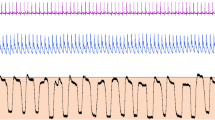Abstract
This study aimed to examine the effects of maximum static and dynamic forces during and after knee-hip extension movement on blood pressure. Blood pressure was measured with a combination of oscillometric and tonometry methods before, during, immediately after and 30 s after knee-hip extension movements performed under maximum isometric and various isotonic force conditions on the servo-controlled dynamometer. The force–velocity relation of knee-hip extension movement was linear (r 2 = 0.9989), so that maximum isometric force (F max) and unloaded velocity (V max) were obtained by extrapolation. F max coincided with measured maximum isometric force (F 0) (F 0/F max = 1.03 ± 0.25). During isometric contraction, mean arterial pressure (MAP) increased to a larger extent and the increase was significantly higher than those during all controlled-load range of isotonic force measurements. The magnitude of MAP response during maximum isometric exercise was positively correlated with both F 0 (r = 0.687, P < 0.01) and V max (r = 0.586, P < 0.05). On the other hand, there was no significant correlation between F 0 and V max (r = 0.451, P > 0.05). It is suggested that measurements of muscular function with isotonic trials cause smaller increase in blood pressure than isometric trials do. Also, it was indicated that individuals with greater muscular strength and speed might respond with larger changes in blood pressure to strenuous muscular exercises.






Similar content being viewed by others
References
Abernethy P, Wilson G, Logan P (1995) Strength and power assessment. Issues, controversies and challenges. Sports Med 19:401–417
Baum K, Essfeld D, Stegemann J (1990) Reduction in extracellular muscle volume increases heart rate and blood pressure response to isometric exercise. Eur J Appl Physiol Occup Physiol 60:217–221
Cui J, Blaha C, Moradkhan R, Gray KS, Sinoway LI (2006) Muscle sympathetic nerve activity responses to dynamic passive muscle stretch in humans. J Physiol 576:625–634
Daniels JW, Stebbins CL, Longhurst JC (2000) Hemodynamic responses to static and dynamic muscle contractions at equivalent workloads. Am J Physiol Regul Integr Comp Physiol 279:R1849–R1855
Harman EA, Frykman PN, Clagett ER, Kraemer WJ (1988) Intra-abdominal and intra-thoracic pressures during lifting and jumping. Med Sci Sports Exerc 20:195–201
Houmard JA, Weidner ML, Koves TR, Hickner RC, Cortright RL (2000) Association between muscle fiber composition and blood pressure levels during exercise in men. Am J Hypertens 13:586–592
Kaufman MP, Longhurst JC, Rybicki KJ, Wallach JH, Mitchell JH (1983) Effects of static muscular contraction on impulse activity of groups III and IV afferents in cats. J Appl Physiol 55:105–112
MacDougall JD, Tuxen D, Sale DG, Moroz JR, Sutton JR (1985) Arterial blood pressure response to heavy resistance exercise. J Appl Physiol 58:785–790
MacDougall JD, McKelvie RS, Moroz DE, Sale DG, McCartney N, Buick F (1992) Factors affecting blood pressure during heavy weight lifting and static contractions. J Appl Physiol 73:1590–1597
Petrofsky JS, Lind AR (1980) The blood pressure response during isometric exercise in fast and slow twitch skeletal muscle in the cat. Eur J Appl Physiol Occup Physiol 44:223–230
Petrofsky JS, Phillips CA, Sawka MN, Hanpeter D, Lind AR, Stafford D (1981) Muscle fiber recruitment and blood pressure response to isometric exercise. J Appl Physiol 50:32–37
Sadamoto T, Mutoh Y, Miyashita M (1992) Cardiovascular reflexes during sustained handgrip exercise: role of muscle fibre composition, potassium and lactate. Eur J Appl Physiol Occup Physiol 65:324–330
Sagiv M, Hanson PG, Ben-Sira D, Nagle FJ (1995) Direct vs indirect blood pressure at rest and during isometric exercise in normal subjects. Int J Sports Med 16:514–518
Sagiv M, Ben-Sira D, Goldhammer E (1999) Direct vs. indirect blood pressure measurement at peak anaerobic exercise. Int J Sports Med 20:275–278
Saito M (1995) Differences in muscle sympathetic nerve response to isometric exercise in different muscle groups. Eur J Appl Physiol Occup Physiol 70:26–35
Sato T, Nishinaga M, Kawamoto A, Ozawa T, Takatsuji H (1993) Accuracy of a continuous blood pressure monitor based on arterial tonometry. Hypertension 21:866–874
Seals DR, Washburn RA, Hanson PG, Painter PL, Nagle FJ (1983) Increased cardiovascular response to static contraction of larger muscle groups. J Appl Physiol 54:434–437
Smolander J, Aminoff T, Korhonen I, Tervo M, Shen N, Korhonen O, Louhevaara V (1998) Heart rate and blood pressure responses to isometric exercise in young and older men. Eur J Appl Physiol Occup Physiol 77:439–444
Wretenberg P, Arborelius UP (1994) Power and work produced in different leg muscle groups when rising from a chair. Eur J Appl Physiol Occup Physiol 68:413–417
Yamauchi J, Mishima C, Nakayama S, Ishii N (2004) The force-velocity relation of human multi-joint movement: a study with force clamp analysis. J Physiol 555P:PC87
Yamauchi J, Mishima C, Fujiwara M, Nakayama S, Ishii N (2007) Steady-state force-velocity relation of human multi-joint movement determined with force clamp analysis. J Biomech 40:1433–1442
Yoneyama K, Kamo T, Watanabe M, Kawana K, Imamura S, Sugihara H, Shimizu T (1990) Blood pressure in resting and tilting by tonometry method with noninvasive continuous blood pressure monitor. Kokyu To Junkan 38:655–658
Author information
Authors and Affiliations
Corresponding author
Rights and permissions
About this article
Cite this article
Yamauchi, J., Nakayama, S. & Ishii, N. Blood pressure response to force–velocity properties of the knee-hip extension movement. Eur J Appl Physiol 102, 569–575 (2008). https://doi.org/10.1007/s00421-007-0626-1
Accepted:
Published:
Issue Date:
DOI: https://doi.org/10.1007/s00421-007-0626-1




